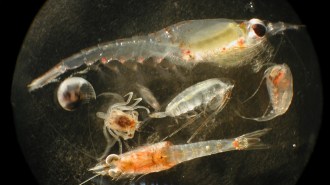Bite-size pieces of plastic chipped from wave-battered consumer products work their way up marine food chains, suggest researchers examining fur seals in Australia.
The oceans are awash in plastic flotsam, and scientists have long studied this debris and its effects on wildlife. Small plastic pellets are a hazard for hungry seabirds, which mistake them for fish eggs or other food. These pellets–the raw material for plastic products–accumulate oily contaminants such as PCBs on their surfaces (SN: 2/3/01, p. 79: Available to subscribers at Plastic debris picks up ocean toxics). Larger refuse, such as fishnets and soft drink containers, has been considered hazardous but generally not because animals confuse it with food.
Between 1990 and 1997, Harry Burton of the Australian Antarctic Division in Kingston, Tasmania, and Cecilia Eriksson of Hobart, Tasmania, collected scat from two species of Antarctic fur seals living along beaches on Macquarie Island, Australia. In 145 droppings that the researchers examined, they found a total of 164 plastic particles. Almost all particles were irregularly shaped–not spherical or cylindrical, as industrial pellets are–and showed evidence of abrasion, suggesting to the researchers that the plastic bits derived from larger pieces.
Seals probably didn’t consume the particles directly. More likely, Burton and Eriksson say in the September Ambio, the seals ate fish that had ingested bits of consumer products broken to pieces by rocks and waves.
****************
If you have a comment on this article that you would like considered for publication in Science News, send it to editors@sciencenews.org. Please include your name and location.







